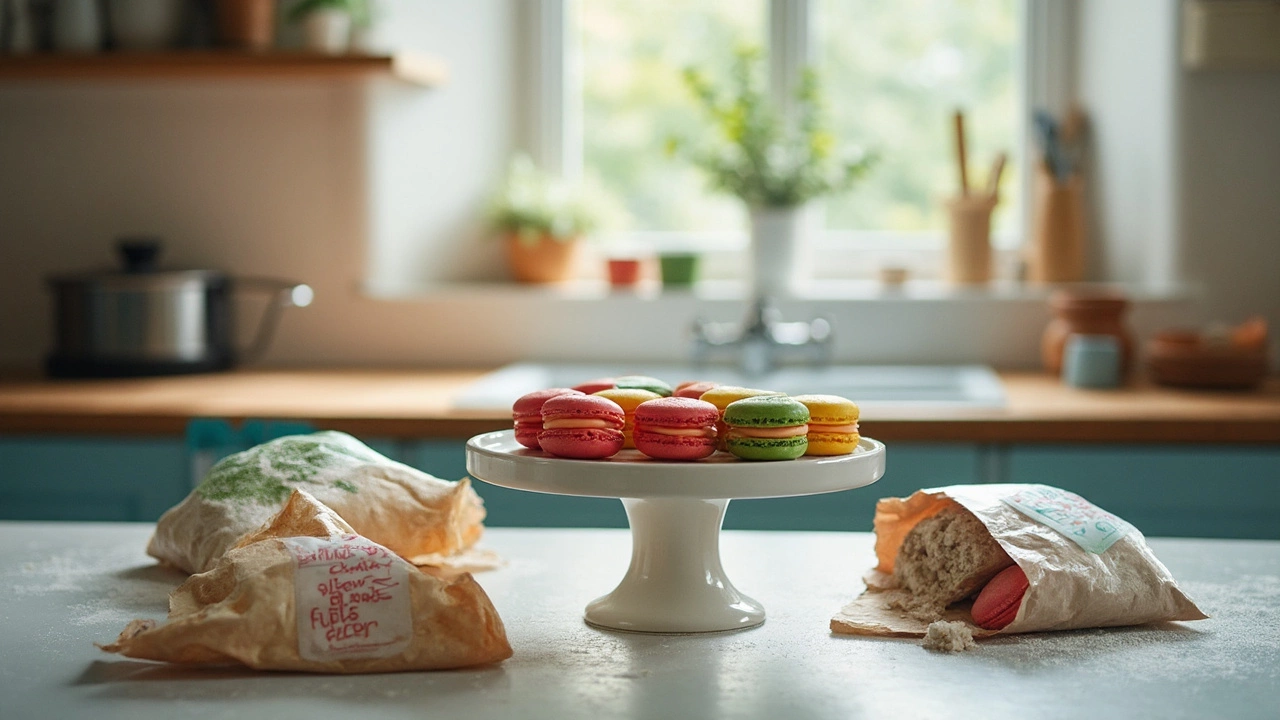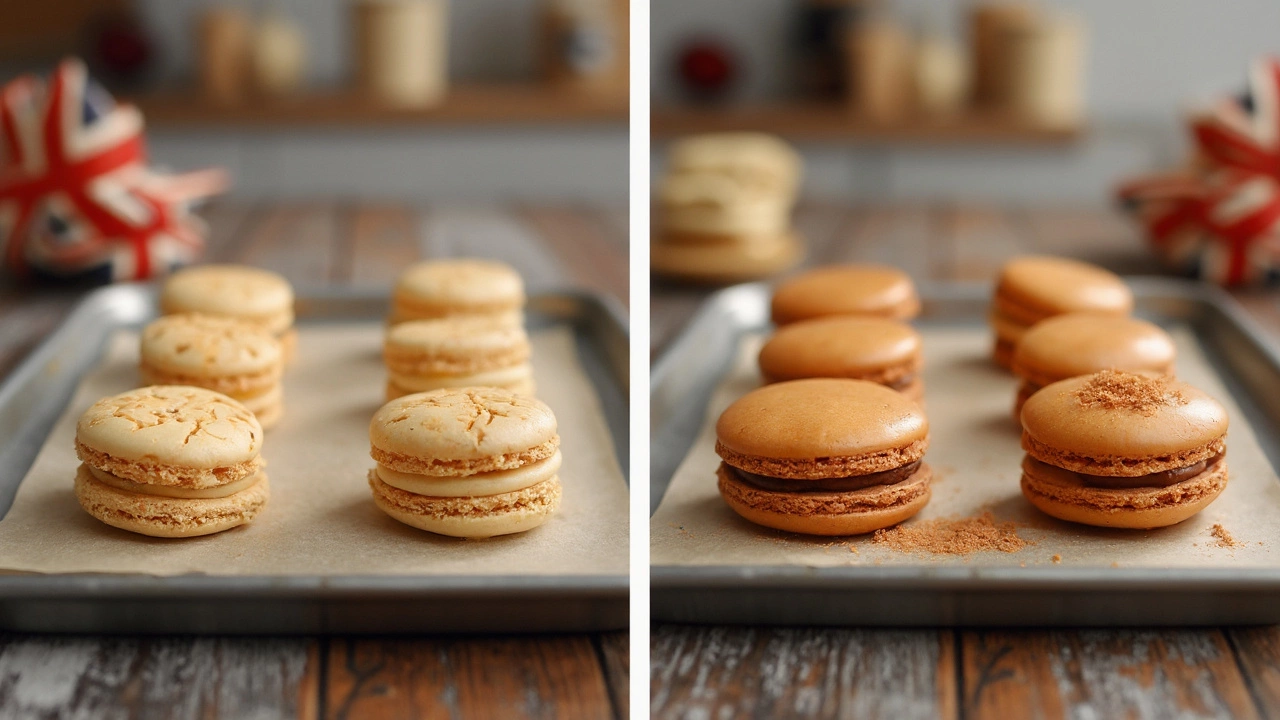
Macarons are fussy. Your flour choice matters way more than you might think. Use the wrong kind, and you'll end up with shells that crack, turn lumpy, or just don't rise right. So, if you're eyeing that bag of almond flour on your kitchen shelf, it’s time to check it twice before reaching for the mixer.
In macaron baking, almond flour isn't just a filler—it's the main character. Your whole texture and structure depend on it. Getting your hands on the right kind saves you from headaches later, trust me. Let's cut through the nonsense and get straight to what you really need to know about picking flour for that perfect, glossy macaron. I'll break down which options actually work, why blanched matters, grind size secrets, and the brands that serious bakers swear by.
- Why Flour Choice Matters for Macarons
- Breaking Down Almond Flour Types
- Blanched vs. Unblanched: Which to Pick?
- Grind Size and Texture Tips
- Brands That Work (and Ones to Avoid)
- Real-World Troubleshooting: Fixing Flour Mistakes
Why Flour Choice Matters for Macarons
If you’ve ever had macarons that are too chewy, absolutely hollow, or taste kind of weird, odds are the flour messed things up. The best flour for macarons affects everything from the texture to the signature feet on each shell. This isn’t like regular baking where a little flour swap barely matters—macarons will call you out the second you get it wrong.
Almond flour is the traditional base for French macarons. But not any old almond flour off the shelf does the trick. The texture needs to be super fine, almost powdery, or your shells will come out grainy and bumpy. If the flour holds too much oil or is even a little moist, you’ll see funky results like cracked tops or collapsed middles. It’s wild how sensitive macarons can be to just a small change in your flour.
Every big pastry school and pro baker stresses that almond flour quality makes or breaks your batch. Check out this comparison of key almond flour traits and their impact on macaron success:
| Trait | Good Impact | Bad Impact |
|---|---|---|
| Fine Grind | Smooth shells, correct rise | Grainy or lumpy shells |
| Low Moisture | Glossy tops, stable feet | Cracked or sticky shells |
| Even Particle Size | Even baking, round shells | Uneven baking, oval shapes |
And it’s not just theory—one time I tried a coarser almond meal in a pinch, and every single shell turned out ugly and crumbly. So yes, invest in the right flour. You’ll taste and see the difference in every single bite.
Breaking Down Almond Flour Types
Alright, time to get real about almond flour. Not all types are created equal—especially when it comes to macarons. You’re gonna see two main kinds at the store: blanched almond flour and unblanched almond meal. The names look alike, but the results in your macaron shells couldn’t be more different.
Blanched almond flour is made from almonds with the skins removed. This makes it fine, pale, and smooth. Unblanched almond meal, on the other hand, is ground with the skins on, which means it’s coarser, darker, and specked with brown bits. Macaron shells simply don't like all that extra texture. Want that classic smooth finish? Go blanched or go home.
Here's how the two stack up side by side:
| Type | Main Difference | Macaron Shell Result |
|---|---|---|
| Blanched Almond Flour | No skins, fine grind | Smooth, light shells |
| Unblanched Almond Meal | With skins, coarser | Rough shells, less rise |
Look out for the word "superfine" or "extra-fine" on the label—this means the flour is ground even smaller, making it perfect for airy macaron shells that aren’t gritty. If the bag just says "almond meal," it's almost always too chunky. Your delicate cookies deserve better.
- Blanched almond flour is what top bakers use for macarons—don't settle for less.
- Almond meal works for rustic cakes or pancakes, not for shiny macarons with feet.
- Grinding your own almonds often leads to uneven texture. Pre-ground, store-bought macaron flour saves tons of trouble.
Some brands even sell almond flour labelled "for macarons" because they've figured out bakers don't want to risk it. When in doubt, go for trusted options. Don't just grab any old almond product and hope for the best.
Blanched vs. Unblanched: Which to Pick?
If your macarons keep coming out gritty or speckled, your almond flour might be to blame. The big difference comes down to blanched versus unblanched almond flour. Here’s the deal: blanched almond flour is made from almonds that have had their skins removed. Unblanched includes those brown skins, ground in with the nuts. This seems small, but for macarons, it’s a game-changer.
Blanched flour is what gives macarons their classic smooth look. The skins in unblanched flour create little dark specks and mess with the texture, so your macaron shells lose that shiny finish and even shape. The batter turns out thicker and doesn’t flow right either, making it much harder to get perfect feet. If you want bakery-style results, you need that fine, pale blanched almond flour—no shortcuts.
- Best flour for macarons is always blanched, superfine almond flour. No exceptions. This keeps your shells light, smooth, and easy to color.
- Skip anything labeled as “almond meal”—that’s almost always unblanched and too coarse for macarons.
- Some folks try sifting unblanched flour to make it finer, but the little bits of skin never really go away. They’ll still show up in both looks and texture.
- If you only have unblanched flour at home, you might get away with it for cookies or brownies, but never for macarons.
So, bottom line: buy blanched, superfine almond flour if you care about pretty macarons that taste light and delicate. If it isn’t labeled as blanched, check for those brown flecks—if you can see them, it’s not what you want.

Grind Size and Texture Tips
The grind size of your almond flour plays a huge role in how smooth and shiny your macarons turn out. For that classic macaron shell look—glossy, with smooth tops and those cute little ruffled feet—you need your almond flour to be super fine. If the grind's too coarse, you end up with bumpy shells or even cracked tops.
Most store-bought almond flours say "finely ground" on the label, but here’s the thing: not all of them actually are. You can test at home. Pinch some flour and rub it between your fingers. If you feel gritty bits, that’s too chunky. Ideally, it should feel like fine sand, not chunky salt. Some bakers swear by sifting the flour at least twice before using, and honestly, it helps.
- Sieve the almond flour together with the powdered sugar. This cuts down on lumps and filters out bigger granules that mess up your batter's texture.
- If your flour isn’t fine enough, blitz it in a food processor for 10-15 seconds, then sift again (but don’t let it turn oily, or you’re in trouble).
Another trick? Mix your almond flour with the powdered sugar before sifting, not after. The sugar helps prevents clumping so everything flows through the sieve much faster. If you’re pressed for time, pick a *really* fine, blanched almond flour to skip the extra prep.
Remember, macaron flour that’s too coarse gives you gritty shells, and nobody’s excited about biting into a grainy macaron. Go as smooth as possible, and your shells will turn out light, smooth, and Instagram-ready every time.
Brands That Work (and Ones to Avoid)
You’d think all almond flour is the same, but that’s not true when it comes to macarons. The best flour for macarons is always finely ground, blanched almond flour—anything less, and your shells could end up grainy, lumpy, or a nightmare to pipe evenly.
Here’s the real talk: most bakers swear by a few brands that just get it right, batch after batch. King Arthur Almond Flour and Bob’s Red Mill Super-Fine Almond Flour are the heavy hitters. Both are widely available, and their texture is reliably fine, making your macaron batter smooth and much easier to work with.
- King Arthur Almond Flour: Consistently the smoothest grind. Hardly any lumps, which means less time sifting and more even shells every time. Even top pastry chefs have given this one the thumbs up.
- Bob’s Red Mill Super-Fine Almond Flour: Slightly pricier, but the powder-fine texture really helps with glossy tops and pronounced feet on your macarons.
- Kirkland (Costco) Blanched Almond Flour: This one is more affordable in bulk and still produces smooth shells, though you might have to sift more for the finest results.
On the other hand, steer clear of “almond meal,” even if it’s cheaper. Brands like Trader Joe’s Almond Meal or store-brand bags labeled as “almond meal” tend to be coarse and include skins, which totally ruin the macaron texture. Your shells will look rustic—if they form at all. Also, beware of random discount brands. Consistency is a struggle, and too many fillers can sneak in.
To see how the most popular options stack up, check out this overview of almond flour brands and what to look out for:
| Brand | Texture | Shell Results | Needs Extra Sifting? |
|---|---|---|---|
| King Arthur Almond Flour | Ultra fine | Smooth, airy shells | No |
| Bob's Red Mill Super-Fine | Very fine | Glossy, neat feet | Rarely |
| Kirkland Blanched Almond Flour | Fine | Good, some sifting helps | Sometimes |
| Trader Joe's Almond Meal | Coarse, with skins | Lumpy, rustic | Often (not recommended) |
| Generic/Discount Brands | Inconsistent | Unreliable | Usually |
Sticking to trusted brands isn’t just snobbery. It’s about giving yourself the best shot at Instagram-worthy macarons, without cursing at cracked batches or having to start over and waste ingredients. If you want less stress, grab one of the top three—it really does make a difference.
Real-World Troubleshooting: Fixing Flour Mistakes
So your macarons came out flat, weirdly textured, or full of holes? It's usually the flour messing things up. Here’s what’s likely going wrong and how to fix it next time.
- Macaron flour is too coarse: If your shells are gritty or lumpy, your almond flour wasn’t ground fine enough. This is super common. Sift the flour before you use it—sometimes twice—until only the finest stuff gets through. If you’ve got a food processor, blend your almond flour and powdered sugar together and then sift for an extra-smooth mix.
- Shells spread like pancakes: This often means the flour has too much oil (some brands are oilier than others) or you used unblanched almond flour. Stick with blanched, and if your flour feels greasy, try spreading it on a sheet pan and drying it out in the oven for a few minutes at low heat.
- Big air pockets or hollow shells: The biggest culprit after poor folding is uneven or chunky almond flour. Always check for lumps and sift, even if the packaging says "super fine." Sifting with powdered sugar helps break up sneaky clumps.
- Egg whites not combining properly: Sometimes, cheap or unfiltered flour can introduce oil or tiny almond skins, messing with how the batter holds together. Fresh, high-quality, defatted blanched almond flour gives better results—don’t cheap out if you want consistency.
One last tip—not all brands are created equal. Some produce way more crumbs or oil than others, even if they claim to be the same. If you change brands and suddenly things go wrong, the flour’s probably the culprit. Keep notes on which brands and batches worked, so you don’t have to play guessing games every time you bake. Small tweaks make a huge difference, and you’ll notice it in every bite.